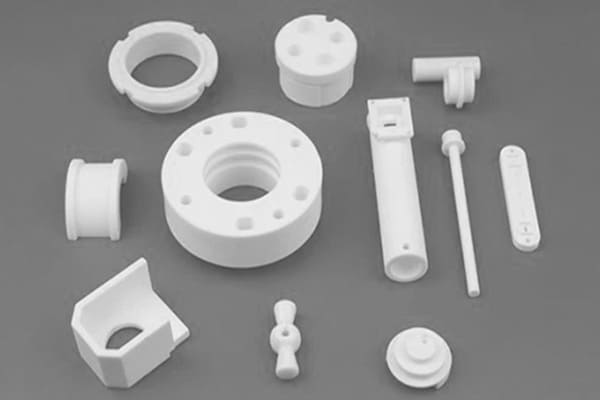Yttria Stabilized Zirconia (YSZ): Why It’s Ideal for High-Temperature Applications
Yttria Stabilized Zirconia (YSZ) is a high-performance ceramic known for its ability to withstand extreme temperatures, making it essential in industries like aerospace and energy production. Pure zirconia (ZrO₂) undergoes phase transformations under thermal stress, causing cracking. However, by adding yttria (Y₂O₃), YSZ gains enhanced stability and durability, making it ideal for high-temperature applications.
At Advanced Ceramics Hub, we specialize in high-quality yttria stabilized zirconia (YSZ) products with a variety of forms and specifications, ensuring optimal performance for industrial and scientific applications.

What is Yttria Stabilized Zirconia?
1. Chemical Composition and Structure
Yttria-stabilized zirconia (YSZ) is a solid solution of zirconium dioxide (ZrO₂) and yttrium oxide (Y₂O₃), where yttrium cations (Y³⁺) substitute a fraction of zirconium (Zr⁴⁺) sites in the crystal lattice. This substitution creates oxygen vacancies due to charge compensation, significantly influencing the material’s phase stability and ionic conductivity.
2. Stabilizing Effect of Yttria
Without yttrium oxide, zirconium dioxide would undergo a phase transformation when heated, which could result in cracking or catastrophic failure. Yttria stabilizes this transformation by encouraging the retention of the high-temperature tetragonal or cubic phases, which have better mechanical properties and higher resistance to thermal shock.
3. Different phases of YSZ
The structure of YSZ can exist in different phases depending on the temperature and the amount of yttria.
(a) Tetragonal YSZ (3–4 mol% Y₂O₃)
- Structure: Slightly distorted cubic lattice (tetragonal symmetry, *P4₂/nmc* space group).
- Key Property: Transformation toughening – Under stress, the t→m transition absorbs energy, increasing fracture toughness (~10–15 MPa·m¹/²).
- Applications: Dental crowns, cutting tools, wear-resistant coatings.
(b) Cubic YSZ (≥8 mol% Y₂O₃)
- Structure: Fully stabilized fluorite-type cubic lattice (Fm3m space group).
- Key Property: High oxygen ion conductivity (σ ~0.1 S/cm at 1000°C) due to abundant oxygen vacancies.
- Applications: Solid oxide fuel cell (SOFC) electrolytes, oxygen sensors.
(c) Partially Stabilized YSZ (Mixed t + c Phases)
- Combines toughness (from t-phase) and conductivity (from c-phase).
- Used in thermal barrier coatings (TBCs) for gas turbines.
4. Key Applications Leveraging Phase Properties
- Tetragonal YSZ: Biomedical implants (hip joints, dental prosthetics) – exploits biocompatibility and toughening.
- Cubic YSZ: SOFCs – optimized for ion transport.
- PSZ/Composite YSZ: Aerospace TBCs – balances thermal insulation and thermal shock resistance.
Looking for top-quality yttria stabilized zirconia (YSZ) products? Explore Advanced Ceramics Hub’s selection.
Key Properties of Yttrium Stabilized Zirconia (YSZ)
1. Mechanical Properties of Yttria Stabilized Zirconia (YSZ)
| Property | Value Range | Significance |
| Fracture Toughness (KIC) | 6–15 MPa·m1/2 | Superior to Al2O3 (3–4 MPa·m1/2); resists crack propagation via t→m transformation. |
| Vickers Hardness (HV) | 12–14 GPa | Comparable to sapphire; ideal for wear-resistant coatings and cutting tools. |
| Flexural Strength | 800–1200 MPa (RT) | Maintains strength up to 1000°C; critical for load-bearing implants. |
| Young’s Modulus | 200–210 GPa | Lower than Al2O3 (~400 GPa), reducing stress shielding in implants. |
2. Thermal Properties of Yttria Stabilized Zirconia (YSZ)
| Property | Value Range | Application Relevance |
| Thermal Conductivity | 2–3 W/m·K (bulk, RT) | Low conductivity enables thermal barrier coatings (TBCs) for turbines. |
| Thermal Expansion Coefficient | 10–11 × 10<sup>−6</sup> /K | Matches metals (e.g., steel), minimizing thermal stress in composite structures. |
| Melting Point | ~2700°C | Stable in extreme heat (e.g., aerospace components). |
| Thermal Shock Resistance | ΔT > 500°C (rapid) | Resists cracking due to transformation toughening. |
3. Electrical & Electrochemical Properties of Yttria Stabilized Zirconia (YSZ)
| Property | Value Range | Functional Importance |
| Oxygen Ion Conductivity | 0.1 S/cm (1000°C, 8YSZ) | Enables SOFC electrolytes and oxygen sensors (e.g., automotive λ-sensors). |
| Activation Energy (Ea) | 0.8–1.1 eV | Lower Ea enhances ion mobility at high temperatures. |
| Bandgap | 5–6 eV | Insulating at RT; transparent forms used in optics. |
4. Chemical & Environmental Stability of Yttria Stabilized Zirconia (YSZ)
| Property | Behavior/Resistance | Applications |
| Corrosion Resistance | Inert to acids/alkalis (pH 1–14) | Crucibles for molten metals, biomedical implants. |
| Oxidation Resistance | Stable in air up to 2000°C | High-temperature coatings (e.g., jet engine components). |
| Biocompatibility | ISO 10993-certified | Dental crowns, hip/knee prosthetics (no immune rejection). |
5. Optical Properties (Transparent YSZ)
| Property | Value Range | Applications |
| Transmittance | >70% (IR range, 5 µm) | Infrared windows, laser components. |
| Refractive Index | ~2.1 (600 nm) | Anti-reflective coatings in optoelectronics. |
Explore our optimized yttria stabilized zirconia (YSZ) products.
Role of Yttria Stabilization
Yttria stabilizes zirconia by preventing phase transformations that cause cracking under temperature changes. Yttrium ions stabilize the tetragonal or cubic phase, ensuring structural integrity even at room temperature and during thermal cycling.
Yttria stabilizes zirconia by replacing zirconium ions with yttrium ions, creating oxygen vacancies that enhance stability and ionic conductivity. This makes the material robust across a wide temperature range. For example, 8 mol% yttria-stabilized zirconia (8YSZ) is commonly used for its balance of stability and performance in high-reliability applications like thermal barrier coatings and fuel cells.
1. Preventing Destructive Phase Transitions
Pure ZrO₂ undergoes three crystalline phases with temperature changes:
- Monoclinic (m) → Tetragonal (t) at ~1170°C → Cubic (c) at ~2370°C
- Upon cooling, the t→m transition causes ~4% volume expansion, leading to cracking.
Yttria’s Role:
✅Y³⁺ ions substitute Zr⁴⁺ sites, introducing oxygen vacancies (charge compensation: 2 Y³⁺ → 1 O²⁻ vacancy).
✅These defects suppress the t→m transition, stabilizing:
- Tetragonal (t’) phase (3–4 mol% Y₂O₃) – Metastable at RT.
- Cubic (c) phase (≥8 mol% Y₂O₃) – Fully stabilized.
Effect: Eliminates catastrophic cracking, enabling practical use.
2. Controlling Mechanical Properties
| Stabilization Level | Phase | Key Mechanical Property |
| 3–4 mol% Y₂O₃ | Tetragonal (t’) | Transformation toughening: Stress-induced t→m transition absorbs energy (~10–15 MPa·m¹/²). |
| ≥8 mol% Y₂O₃ | Cubic (c) | Lower toughness (~1–3 MPa·m¹/²) but higher ionic conductivity. |
Why it matters:
- 3YSZ (3 mol%): Used in dental implants and cutting tools (high strength + crack resistance).
- 8YSZ (8 mol%): Favored for SOFCs (prioritizes ion transport over toughness).
3. Enhancing Ionic Conductivity
- Mechanism: Oxygen vacancies (from Y³⁺ doping) enable O²⁻ ion hopping.
- Conductivity vs. Y₂O₃ Content:
| Y₂O₃ (mol%) | Phase | σ (S/cm, 1000°C) |
| 3–4 | Tetragonal | ~0.01 |
| 8 | Cubic | ~0.1 |
| 10+ | Cubic | Declines (excess vacancies cluster). |
Optimal Composition: 8YSZ balances vacancy concentration and mobility.
4. Tailoring Thermal Stability
Thermal Expansion Matching:
- YSZ’s CTE (~10–11 × 10⁻⁶/K) aligns with metals (e.g., steel), reducing interfacial stresses in coatings.
Phase Stability at High T:
- Cubic YSZ remains stable up to melting (~2700°C), unlike unstabilized ZrO₂.
Application: Thermal barrier coatings (TBCs) for turbine blades.
Discover our high-quality yttria stabilized zirconia (YSZ) products.
Applications of Yttria Stabilized Zirconia (YSZ) in High-Temperature Environments
Yttria-stabilized zirconia (YSZ) is widely used in extreme thermal conditions (typically 800–2000°C) due to its phase stability, low thermal conductivity, and chemical inertness. Below are its key high-temperature applications, categorized by industry:
1. Thermal Barrier Coatings (TBCs) – Aerospace & Energy
Purpose: Protect metallic components (e.g., turbine blades) from heat and oxidation.
Why YSZ?
- Low thermal conductivity (~2.3 W/m·K at 1000°C).
- High melting point (~2700°C).
- Thermal expansion matches with superalloys (CTE ~10–11 × 10⁻⁶/K).
Structure:
- 7–8 wt% YSZ (cubic/tetragonal) deposited via plasma spraying or EB-PVD.
- Multilayer system: YSZ topcoat + bond coat (MCrAlY) + superalloy substrate.
Performance:
- Reduces substrate temperature by 100–300°C.
- Lifetime: 10,000+ hours in jet engines.
Challenges:
- Sintering above 1200°C → conductivity increases.
- CMAS attack (calcium-magnesium-alumino-silicates) in jet engines.
2. Solid Oxide Fuel Cells (SOFCs) – Energy
Role: Electrolyte material for O²⁻ ion transport.
Why YSZ?
- High ionic conductivity (~0.1 S/cm at 1000°C for 8YSZ).
- Zero electronic conductivity (prevents short-circuiting).
- Gas-tight dense structure (prevents fuel crossover).
Design:
- Thin-film 8YSZ (10–50 µm) sintered at ~1400°C.
- Operates at 800–1000°C (lower T reduces degradation).
Limitations:
- Brittleness → prone to thermal cycling cracks.
- Alternative: Scandia-stabilized zirconia (ScSZ) for lower-T operation.
3. Oxygen Sensors – Automotive & Industrial
Function: Monitor O₂ levels in exhaust gases (e.g., automotive λ-sensors).
Why YSZ?
- Fast ion transport enables rapid voltage response.
- Chemical stability in corrosive exhaust environments.
Mechanism:
- Nernst equation generates voltage proportional to O₂ partial pressure.
- Operating T: 400–900°C (heated for quick startup).
Example:
- ZrO₂-based λ-sensor in cars (optimizes combustion efficiency).
4. Refractories & Crucibles – Metallurgy
Use: Containers for molten metals (e.g., steel, titanium).
Why YSZ?
- Resists corrosion by slag/acids (pH 1–14).
- Thermal shock resistance (ΔT > 500°C).
Grades:
- PSZ (3–4 mol% Y₂O₃): For intermittent heating.
- Fully stabilized (8YSZ): For continuous high-T use.
Limitation: Expensive vs. alumina/magnesia refractories.
5. High-Temperature Electrolysis (HTE) – Hydrogen Production
Role: Electrolyte in steam electrolyzers (H₂O → H₂ + ½O₂).
Why YSZ?
- Stable in steam/O₂ atmospheres up to 1000°C.
- Compatible with Ni-YSZ cermet electrodes.
Efficiency: ~90% electrical-to-hydrogen efficiency at 800°C (vs. ~70% for PEM electrolyzers).
6. Nuclear Reactor Components – Fission/Fusion
Applications:
- Inert matrix fuel (IMF) for transmutation of nuclear waste.
- Thermal insulation in fusion reactors (e.g., ITER).
Advantages:
- Radiation resistance (minimal swelling).
- Low neutron absorption cross-section.
Advantages of Yttria Stabilized Zirconia (YSZ) Over Other Materials
YSZ outperforms other ceramics and metals in high-temperature, mechanical, and electrochemical applications due to its unique combination of properties. Below is a detailed comparison with common alternatives:
| Material | Thermal Stability | Mechanical Strength | Chemical Inertness | Cost | Ionic Conductivity |
| YSZ | Excellent (up to 2500°C) | High toughness at high temp | Very high | Moderate | Yes (high temp) |
| Alumina | Good (up to 1800°C) | Moderate | High | Low | No |
| Silicon Carbide | Very good (up to 2000°C) | High | Moderate | High | No |
| Magnesia | Good (up to 2000°C) | Low | High | Moderate | No |
Request a custom quote for high-quality yttria stabilized zirconia products.
Challenges and Limitations
Despite its many advantages, YSZ is not without challenges. Understanding these limitations is crucial for optimizing its use and guiding future improvements. Key challenges include:
- Processing Difficulties: Fabricating YSZ components requires high sintering temperatures (often above 1400°C), which increases energy costs and production complexity. Achieving uniform yttria distribution in the zirconia matrix is also technically challenging.
- Brittleness: While YSZ is tougher than many ceramics, it remains brittle under extreme mechanical stress, particularly in applications involving high impact or cyclic loading. This can lead to cracking or failure in certain scenarios.
- Future Improvements: Ongoing research aims to address these issues. For example, advancements in additive manufacturing (3D printing) are reducing fabrication costs, while new dopants and composite materials are being explored to enhance toughness and reduce brittleness.
These challenges highlight the need for continued innovation to fully unlock YSZ’s potential in high-temperature applications.
At Advanced Ceramics Hub, we supply optimized-grade ceramic products that comply with ASTM and ISO standards, ensuring outstanding quality and reliability.
Yttrium Stabilized Zirconia (YSZ) is an ideal material for high-temperature applications due to its unique combination of thermal stability, mechanical strength, low thermal conductivity, and chemical resistance. Whether used in gas turbines, fuel cells, or thermal barrier coatings, YSZ helps improve the performance, efficiency, and durability of high-temperature systems.
As technology advances, there may be further improvements in the manufacturing of YSZ, reducing costs and enhancing its performance. Research into alternative stabilizers or composites may also yield new materials that offer similar benefits at even higher temperatures or with enhanced mechanical properties.
For top-quality ceramic products, Advanced Ceramics Hub provides tailored solutions and precision machining techniques for various applications.
Looking for premium yttria stabilized zirconia (YSZ) products? Contact us today!
